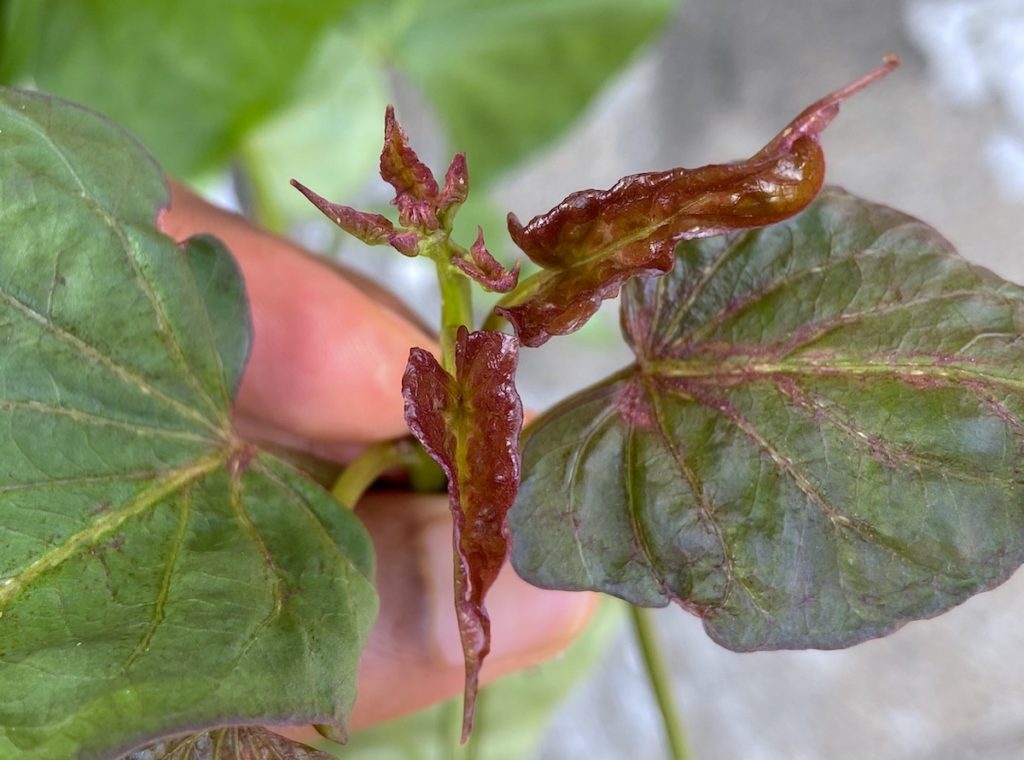Often overlooked because of the delicious sweet potatoes themselves, the leaves of the sweet potato plant are nourishing as well. Sweet potatoes grow in the soil unseen, but above them is where all of the action is happening. Given enough space sweet potato vines are prolific. They will act as ground cover, stretching across your yard, and when given the opportunity to climb, will grab hold of nearby plants, posts, and fences. With plenty of sun provided, the heart shaped leaves stay ever stretching to find new opportunities to sun bathe.

Any gardeners reading are likely to join in our enthusiasm for these tasty leaves. The same can’t be said of regular potato leaves which can be toxic. Pumpkin, squash and other gourds have leafy vines, but the leaves have a sticky layer on them that needs to be peeled. Then there’s the incredibly popular cruciferous greens like kale which are well known, but sweet potato leaves are seldom as bitter, often being neutral tasting. This means they’re also good for introducing more green into the diet of young people as well.
A few ideas for cooking sweet potato include having them raw in a salad, or as an addition to a green smoothie. When harvesting them for a salad, look for the tender young leaves, often a deeper color than the larger leaves. For stews, stir frys, and any heavier cooking, the larger leaves hold up well. We use the beautiful new leaves as a colorful and tender garnish on top of other dishes as well. These leaves appear darker in color and more waxy looking, but lose this sheen as they grow larger.
Today we want to share a bowl of simple, sweet potato soup. The recipe is versatile, allowing for lots of variations. Feel free to make it your own, using different vegetables and locally grown herbs if needed. The point is for the soup to be a vehicle for nutrition, and a champion for biodiversity. The flavor comes from the combination of soft and hard aromatics in the recipe, basil leaves and lemongrass, and should only be mildly sweet with an optional touch of heat from fresh chili. Enjoy the recipe below with a heap of sweet potato leaves, and any other nearby and nutritious ingredients you have to add.
Ingredients
- Serves: 4-6 people
- Equipment: mortar and pestle, pot
- Prep & Cooking Time: 30 minutes
1L water or stock
500g sweet potato leaves
500g winter melon (substitute another soft gourd like zucchini if needed)
1 angled gourd, sliced
1 carrot, sliced
5 lemongrass stalks, smashed
6 shallots, smashed
4 coriander roots, smashed
3-4 fresh Thai chili (substitute with mild chili or bell pepper if desired)
1 tbsp of palm sugar
1 cup of soy sauce
1 tsp of salt
1 tsp of black soy sauce
1 bunch of lemon basil (or other sweet tasting herb leaf, like Italian basil)
Instructions
1) Prep all your ingredients, washing and peeling as neccesary. Before you start cooking, consider which vegetables you’re adding that may need more time than others to cook.
2) Pound your shallots, coriander root, and lemongrass in a mortar and pestle. Or bruise with a heavy object.
3) Add water to your pot with these three aromatics (shallot, lemongrass, and coriander root) and bring to a boil.
4) When the soup is fragrant and lightly boiling, add any tough vegetables like carrot, followed later by soft veg like winter melon and angled gourd. Cook until soft.
5) Adjust your heat to low and season by adding your palm sugar, soy sauce, black soy sauce, and salt. Taste and adjust as needed.
6) Turn off the heat and add your fresh handful of lemon basil.
7) When serving remember to avoid adding lemongrass into your serving bowl. You can remove it completely, but leaving it in the soup will allow it to continue to add flavor to the broth.
This recipe is suitable for a large family of 5-6 people and may put a big dent in your garden. Don’t worry though, the sweet potato plants are resilient, and can survive your pruning and nibbling. Do let us know if you loved this recipe by donating to our charitable work, or signing up for one of our online classes. Then check back soon for more updates and recipes!





